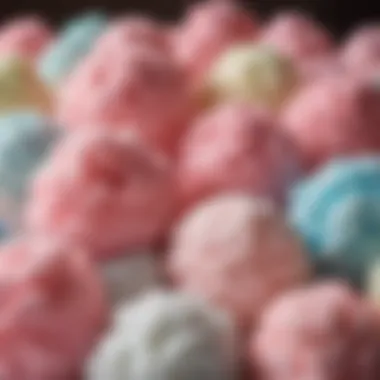Exploring Kroger Cotton Candy: Sweet Delights Unveiled


Intro
Kroger cotton candy is more than just a sugary option at your local grocery store. It embodies a blend of nostalgia and culinary innovation. This article will take a closer look at its origins, production methods, flavor variations, and nutritional aspects. Understanding these components is vital not just for food enthusiasts but also for culinary professionals looking to explore new avenues in the world of sweets.
Cotton candy, as a concept, traces back to the late 19th century. However, the modern iterations, particularly those found at Kroger, continue to evolve. This exploration sheds light on the various ways this fluffy confection has influenced consumer culture. By unpacking the elements that make Kroger cotton candy unique, one can appreciate its role in contemporary culinary practices.
The Sweet Journey of Cotton Candy
Cotton candy’s journey began with the simple idea of transforming sugar into fluffy clouds of sweetness. The invention of the cotton candy machine allowed for this transformation. Over time, the confection has seen various brands and flavor innovations.
Production Methods
Kroger, as a major retailer, sources its cotton candy from specialized producers. These producers use machines that rapidly spin granulated sugar, incorporating air and coloring to create the iconic fluffy texture. This manufacturing process ensures consistency in quality and flavor while maintaining a light, airy product.
Flavor Varieties
Kroger offers a variety of cotton candy flavors that cater to different tastes. Popular options include classic flavors like:
- Blue Raspberry
- Cherry
- Bubble Gum
- Grape
The diverse selection appeals to both children and adults, making it a versatile treat for any occasion.
Nutitional Information
When considering the place of Kroger cotton candy in a diet, it's essential to examine its nutritional profile. Generally, cotton candy is high in sugar content. A standard serving size can contain around 110 calories, primarily from carbohydrates. It is also devoid of essential nutrients, so moderation is advisable.
Important Note: While cotton candy can bring joy, it is not meant to replace healthier snacks.
End
In this culinary exploration, Kroger cotton candy emerges as a delightful yet indulgent treat. Its roots, production, flavor diversity, and nutritional considerations offer valuable insights. As consumers continue to cherish sweet treats, understanding products like cotton candy becomes crucial for making informed choices in today's food landscape.
Preface to Cotton Candy
Understanding cotton candy is essential within the context of this article, as it sets the stage for exploring its various dimensions. Cotton candy is often associated with fun events, fairs, and childhood memories. However, it is more than just a nostalgic treat. Its cultural significance, production methods, and evolving flavors reveal much about food innovation and consumer preferences.
In this article, we will delve into cotton candy, focusing on its definition, history, production processes, and its wide-ranging appeal. For many, cotton candy serves as a delightful indulgence, but it also represents a culinary evolution. We will examine the popular products available at Kroger, a notable player in the confectionery market.
What is Cotton Candy?
Cotton candy, also known as candy floss, is a confection made by heating and cooling sugar, which is then spun into thin strands that create a light, fluffy texture. The process involves melting sugar in a specially designed machine, where it is rapidly cooled to transform into fine strands. These strands clump together, forming the recognizable fluffy mass.
It is typically served on a stick or in bags, and widely recognized for its lightness and melt-in-the-mouth quality. The unique texture and sweetness make it appealing to consumers of all ages. Cotton candy is not just a treat, it is an experience, often associated with festivals, amusement parks, and celebrations.
Historical Background
The origin of cotton candy dates back to the 18th century, with early versions appearing in Europe. The first recorded method was manual and involved a labor-intensive process. In the late 19th century, a significant breakthrough occurred with the invention of the electric cotton candy machine by William Morrison and John C. Wharton. This innovation made the production of cotton candy more efficient and popularized it in the United States.
Cotton candy quickly became a staple at circuses and fairs, gaining prominence as a treat for children and adults alike. Its vibrant colors and flavors contributed to its widespread appeal. Over the years, cotton candy has continued to evolve, with new flavors and presentations emerging, reflecting changing consumer tastes and cultural influences.
In summary, cotton candy is not merely a sweet treat; it embodies a rich history of confectionery innovation and captures the essence of joy and festivity.
Kroger's Cotton Candy Range
Kroger's Cotton Candy range plays a vital role in understanding the brand's commitment to sweet treats that cater to a diverse consumer base. Recognizing the nostalgia and joy associated with cotton candy, Kroger has integrated this product into its extensive inventory. Not just a snack, cotton candy embodies moments of celebration, leisure, and fun, often found at fairs or amusement parks. However, Kroger brings this iconic confection to the everyday consumer, making it easily accessible from grocery aisles. This democratization of cotton candy elevates it from just a carnival novelty to a mainstream delight, suitable for varied occasions.
Product Overview


Kroger offers a selection of cotton candy that aims to meet the needs of different palates. The traditional cotton candy, known for its fluffy texture and sweetness, is just one option. Kroger includes additional varieties and packaging sizes to enhance consumer choice. For families, larger bags are available which provide excellent value for recreational events or gatherings.
Unlike local fairs where a cone is the usual serving, Kroger packages its cotton candy in resealable bags. This format encourages casual snacking, allowing consumers to enjoy the confection at their own pace. The brand prioritizes convenience without compromising on the quality and taste that cotton candy fans expect.
Popular Flavors
The flavor profile of Kroger's cotton candy is diverse, appealing to a wide audience. One of the standout flavors is classic pink vanilla, which remains a favorite due to its timeless appeal. In addition to this, there are other flavors such as blue raspberry, which offers a tangy twist, and grape, providing a nostalgic touch that many consumers remember from childhood.
Other notable flavors include:
- Bubblegum
- Cotton Candy Swirl
- Strawberry
These flavors cater to varied preferences, and Kroger often promotes limited-time flavors to maintain consumer interest.
Limited Edition Variants
In addition to its core flavors, Kroger occasionally introduces limited edition variants of cotton candy. These seasonal releases often tie into holidays or specific events, providing consumers with a unique product that adds excitement. For example, during Halloween, a candy corn flavor might appear, while Christmas could see the introduction of peppermint cotton candy.
These limited editions not only encourage customers to try new flavors but also create a sense of urgency to purchase before they disappear from the shelves. This strategy helps Kroger maintain consumer engagement and stimulates sales during these festive periods.
Production Process of Cotton Candy
The production process of cotton candy is crucial in understanding not only how this sugary delight is made but also what gives it its unique texture and flavor. Many food enthusiasts seek to know the science behind their favorite treats, and cotton candy is no exception. By examining the production aspects, we uncover the blend of craftsmanship and technology involved in creating this whimsical confection. The process ensures quality while maintaining safety, essential factors for consumer satisfaction. Understanding this topic adds value to anyone intrigued by culinary arts or food manufacturing.
Ingredients Used
Creating cotton candy requires a few simple yet vital ingredients. The primary ingredient is granulated sugar, which forms the foundation of this treat. This sugar is often supplemented with food coloring and flavoring agents to enhance its appeal. Here are some key points regarding the ingredients:
- Granulated Sugar: This is the core component. It melts quickly under heat and transforms into the fine strands that cotton candy is known for.
- Flavors: Various flavors can be added to differentiate products. Common choices include raspberry, blue raspberry, vanilla, and even more exotic options.
- Coloring: Food dyes are used to give cotton candy its vibrant hues. This not only makes the treat visually appealing but also signals to the consumer the flavor within.
- Stabilizers: Occasionally, additives are included to improve texture and shelf-life. However, many brands, including Kroger, prefer to keep their cotton candy simple and focused on taste.
The combination of these ingredients is critical. They must work together to ensure the desirable lightness and airy feel of cotton candy, contributing to its quintessential experience.
Manufacturing Techniques
The manufacturing of cotton candy involves several steps, each carefully designed to create the beloved treat. The following methods are typically engaged in production:
- Heating Process: The sugar is heated in a machine until it melts. This melting point is precisely controlled to avoid burning.
- Spinning Mechanism: Upon reaching the right temperature, the melted sugar is forced through tiny holes using centrifugal force. This transforms the liquid sugar into fine threads, creating the light and fluffy strands characteristic of cotton candy.
- Collection: The spun sugar strands are collected around a cone or stick, forming the final shape. This step is often done manually to ensure optimal fluffiness.
- Flavor and Coloring Application: As the sugar spins, flavors and colors are integrated into the sugar strands, ensuring an even distribution of both.
- Packaging: Finally, the cotton candy is carefully packaged to maintain freshness and prevent moisture from affecting its texture.
Kroger produces its cotton candy with precision to uphold quality standards. By focusing on both the artistic and technical aspects of cotton candy production, Kroger maintains a competitive edge in the market.
"The art behind cotton candy is just as important as the science, resulting in a product that's both visually addictive and delicious.”
In summary, the production process of cotton candy signifies a blend of simplicity and careful technique. Understanding the ingredients and manufacturing techniques will offer deeper insights into what makes Kroger cotton candy special.
Nutritional Aspects
The examination of nutritional aspects is crucial in understanding Kroger cotton candy, especially for consumers who are interested in their dietary choices. This section aims to dissect the nutritional value of cotton candy, clarifying how it fits within a balanced diet. As sweet treats, cotton candies can invite questions regarding their caloric impact and ingredients. Understanding these factors can help consumers make informed choices, and perhaps indulge safely without overindulgence.
Caloric Content
Kroger cotton candy, like most sugary confections, presents a significant caloric punch. On average, a serving containing about 1 ounce can have around 100 to 150 calories. This may seem minimal compared to other desserts, yet moderation is essential. Knowing that such a light and airy treat comes with a caloric toll can influence consumer decisions, specifically for those who are keeping close tabs on their weight or caloric intake.
Ingredients Breakdown
The ingredients list of Kroger cotton candy is quite straightforward. Primarily, it consists of sugar, food coloring, and flavoring. Here is a quick breakdown of these components:


- Sugar: The main ingredient providing sweetness and structure.
- Food Coloring: Added to create the vibrant hues characteristic of cotton candy.
- Flavoring Agents: These can range from traditional choices like vanilla or strawberry to more unique selections that may vary by season.
Each ingredient has its role, with sugar being the predominant component. However, it is often important to note that while these ingredients are relatively basic, consumers with allergies or dietary restrictions need to check labels.
Sugar and Dietary Considerations
Sugar, despite its delightful taste, comes with dietary implications. For those monitoring sugar intake, whether for health reasons or personal preference, understanding the sugar content in cotton candy is vital. A typical serving can contain 20 to 30 grams of sugar. This is where mindfulness in consumption becomes critical. High sugar consumption can lead to various health issues over time, including obesity and dental problems.
Cultural Significance of Cotton Candy
Cotton candy holds a distinct position in the realm of sweet treats, often associated with joyous moments and vibrant experiences. Its light, fluffy texture evokes feelings of nostalgia, connecting many to childhood memories at fairs or carnivals. Beyond mere enjoyment, cotton candy has evolved into a cultural symbol representing celebration and whimsy. Understanding its significance enhances appreciation for this confectionery delight.
Cotton Candy in Pop Culture
The portrayal of cotton candy in popular culture is widespread and varied. In various films, television shows, and art, this sweet treat signifies innocence and fun. A notable example is its frequent appearance at amusement parks, where it becomes part of the overall experience. Cotton candy is often shown being devoured by children, embodying carefree days. Furthermore, its vivid colors and playful shapes make it a visually appealing subject for photography, often featured on social media platforms like Instagram and TikTok.
In marketing, brands use cotton candy imagery to draw connections to childhood joy and playful experiences. These associations sometimes influence buying choices, particularly among families looking to create memorable moments. Therefore, the presence of cotton candy in pop culture is not merely accidental; it reflects a deeper connection between food and meaningful experiences.
Role in Events and Celebrations
Cotton candy plays a significant role in various events and celebrations. It often features prominently during festivals, birthday parties, and outdoor gatherings. This sugary fluff brings a sense of festivity and adds to the atmosphere. It is particularly popular at county fairs, where vendors may serve it fresh, enhancing the charm of the event.
During special occasions, cotton candy can be tailored to match themes or color schemes, further elevating its celebratory appeal. Many bakeries and caterers offer cotton candy as a whimsical addition to dessert tables. This versatility allows it to fit into various contexts, from formal events to informal gatherings.
- Popular Occasions for Cotton Candy:
- Birthday parties
- Weddings
- Festivals and fairs
- Holiday celebrations
Consumer Reception of Kroger Cotton Candy
Understanding the consumer reception of Kroger cotton candy is vital to put into perspective its place in today’s confectionery landscape. This section highlights how buyers perceive the product, the importance of their feedback, and how it influences market trends. Gauging consumer opinions provides insight into not just customer satisfaction, but also preferences shaped by cultural influences and changing dietary needs. Each piece of feedback contributes to the evolving dialogue surrounding sweet treats and, ultimately, the success of a product like cotton candy.
Customer Feedback
Customer feedback for Kroger cotton candy often reflects a blend of nostalgia and novelty. Many consumers enjoy the return to childhood memories associated with fairs and festivals, where cotton candy is a quintessential treat. Positive reviews frequently mention the lightness and fluffiness of Kroger's cotton candy, distinguishing it from heavier dessert options. Some customers appreciate the straightforward taste that evokes joyful memories.
However, not all feedback is positive. Concerns about the quantity of sugar and its nutritional value appear consistently in reviews. Consumers who are health-conscious sometimes express disappointment over the excessive sweetness, suggesting they desire more diverse flavor options that balance sweetness with other flavor profiles.
"Kroger’s cotton candy takes me back to my childhood, but I wish they offered more flavor combinations. Some fruity and tart flavors could really enhance the experience!"
Market Trends
Market trends surrounding cotton candy show a fascinating evolution influenced by changing consumer tastes and dietary considerations. In recent years, there is a noticeable shift towards healthier snacking options. Surprisingly, cotton candy, with its whimsical nature, has found a niche within this trend through gluten-free and vegan offerings. This diversification makes it appealing to a wider audience.
Social media has played a crucial role in shaping market trends, especially among younger consumers. Platforms such as Instagram and TikTok showcase visually appealing cotton candy creations, igniting interest and demand. These platforms drive conversations around unique flavor combinations and presentation styles, encouraging brands like Kroger to innovate.
Thus, the consumer reception of Kroger cotton candy not only highlights preferences and trends but also paves the way for future product developments and marketing strategies, ensuring that it stays relevant in an ever-evolving market.
Cotton Candy and Dietary Restrictions
In today's food landscape, dietary restrictions and preferences are becoming more prevalent. As consumers become more aware of their health and lifestyle choices, it is important for food manufacturers to consider these factors. This section discusses how Kroger's cotton candy fits into this evolving narrative, specifically addressing gluten-free options and vegan considerations. Understanding these aspects is crucial for those who wish to enjoy this sweet treat without compromising their dietary needs or beliefs.
Gluten-Free Options
For individuals with gluten sensitivities or celiac disease, finding safe sweet treats can be challenging. Fortunately, cotton candy is naturally gluten-free. The primary ingredients typically include sugar and flavorings, none of which contain gluten. However, it's essential to be cautious with cross-contamination during the manufacturing process. Kroger provides clear labeling on their packaging, ensuring consumers know if there is any potential exposure to gluten during production.


- Key aspects to consider:
- Always check the packaging for gluten-free certifications.
- Be aware of the manufacturing environment and potential cross-contact with gluten-containing products.
- Kroger's commitment to allergen labeling helps maintain transparency for customers.
Vegan Considerations
Another important aspect for many consumers today is adhering to a vegan lifestyle. Traditional cotton candy is often made from sugar, which appears harmless; however, the processing of sugar can raise concerns. Some sugars are processed using bone char, which is not suitable for vegans. Kroger has addressed this consideration by offering options that specify plant-based ingredients. Many of their cotton candy products are likely to be suitable for vegans, but again, verification through labeling is crucial.
- Points to check for vegan consumers:
- Look for products that explicitly state they are vegan.
- Review ingredient lists for any animal-derived additives, such as gelatin.
- Assess how the sugar is processed.
The movement towards inclusivity in the food industry necessitates brands like Kroger to adapt. By providing gluten-free and vegan options, they cater to a broader audience. This kind of awareness not only enhances consumer satisfaction but also aligns with the growing demand for conscious consumption in the marketplace.
Innovative Uses of Cotton Candy in Culinary Practices
Cotton candy is often viewed as a simple carnival treat. However, its applicability in culinary arts extends far beyond its traditional context. The exploration of innovative uses for cotton candy allows culinary practitioners and food enthusiasts to engage with this sweet treat in a different light. Understanding these uses can lead to new recipes, creative presentations, and unique flavor pairings that captivate both the eyes and palate. Moreover, incorporating cotton candy into dishes opens a playful dialogue about texture and sweetness, which can elevate standard desserts to new heights.
Cotton Candy in Desserts
Cotton candy has made its way into modern desserts, transforming the way sweet dishes are prepared and presented. Chefs are known to incorporate cotton candy into various desserts, such as ice creams, cakes, and puddings. This technique not only adds a whimsical element but also contributes to contrasting textures within the dish.
For instance, a simple scoop of vanilla ice cream can be topped with wisps of cotton candy, creating a delightful visual appeal and an unexpected texture. The ethereal nature of cotton candy provides a sugar rush that complements the creamy base. Similarly, cotton candy can be incorporated into milkshakes, where it melts slightly, blending with the drink and providing bursts of sweet flavor.
Some innovative chefs even utilize cotton candy to create desserts that draw on nostalgia, merging childhood memories with modern culinary trend. By crafting unique desserts like cotton candy cupcakes or cotton candy-infused cheesecakes, it bridges the gap between generations, offering something for everyone.
Creative Flavor Combinations
The flavor profile of cotton candy is chiefly centered around sweetness, which lends itself well to creative combinations with various flavors. One popular trend in culinary practices is pairing cotton candy with unexpected ingredients to create bold, interesting desserts.
For instance, combining cotton candy with citrus flavors, like lemon or lime, can provide a refreshing contrast. The inherent sweetness of the cotton candy balances the tartness, inviting a harmonious experience. Additionally, more savory flavors, such as matcha or sea salt caramel, can create a unique juxtaposition, engaging more complex flavor dynamics.
Other flavor combinations might include:
- Chocolate: Cozy richness meets airy sweetness.
- Fruit: Berries with cotton candy can produce visually stunning presentations.
- Spices: A hint of cinnamon or nutmeg can add depth to the sweetness.
By experimenting with these combinations, chefs and home cooks alike can discover how to transform classic sweet dishes into something extraordinary, encouraging culinary innovation.
"Innovative uses of cotton candy are reshaping the dessert landscape, making it not just a treat for fun fairs but a versatile ingredient in sophisticated culinary practices."
The versatility of cotton candy is truly significant. It not only provides a means to appeal to a younger audience but also offers opportunities for creative exploration in professional and home kitchens, leading to a diverse range of flavor possibilities.
The End
In this article, we explored the intricate world of Kroger cotton candy and its multifaceted aspects. The significance of the conclusion lies in consolidating the findings, which span the product's origin, production processes, diverse flavors, nutritional information, and its culinary role in contemporary society. It serves to reaffirm the appeal of cotton candy beyond its status as a mere confection.
Summarizing Key Points
Kroger cotton candy represents a blend of tradition and innovation, deserving recognition for a number of reasons:
- Rich History: Understanding how cotton candy has evolved highlights its historical popularity in various contexts.
- Diverse Flavor Offerings: The variety available caters to a wide audience, making it a versatile treat. Popular options include classic flavors like strawberry and blue raspberry, while limited editions keep the experience fresh.
- Consumer Reception: Positive feedback from customers emphasizes the product's quality and enjoyment. Market trends indicate a sustained interest in sugary confections, bolstered by Kroger's offerings.
- Nutritional Insights: The breakdown of caloric intake and ingredients sheds light on its place in dietary considerations. It is crucial for consumers to be aware of sugar content while indulging.
- Cultural Importance: Cotton candy's presence in culture, from fairs to childhood memories, shapes its identity in collective consciousness.
These facets collectively paint a comprehensive picture of what Kroger cotton candy represents in the modern culinary landscape.
The Future of Cotton Candy Products
Looking ahead, the future of cotton candy products shows potential for growth and evolution. Several factors could influence its trajectory:
- Health-Conscious Trends: As consumers become more health-conscious, there may be a rise in options that feature natural sweeteners or reduced sugar levels.
- Innovative Flavors: The introduction of unique flavor combinations can draw in varying palates. For instance, combining cotton candy with elements from desserts like cakes or ice creams can spark interest.
- Sustainability: As with many food products, focusing on sustainability—such as eco-friendly packaging—might become vital for attracting consumers who prioritize environmental considerations.
- Culinary Experimentation: Increased experimentation in culinary uses could expand its application beyond a simple treat. Integrating cotton candy into recipes for gourmet desserts or beverages could pave the way for novel dining experiences.
In summary, Kroger cotton candy holds a significant place in the confections market, with potential for continued innovation and adaptation in response to evolving consumer preferences.















